Wrington
| Wrington | |
| Somerset | |
|---|---|
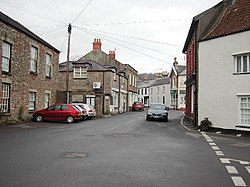 Wrington High Street | |
| Location | |
| Grid reference: | ST470628 |
| Location: | 51°21’40"N, 2°45’47"W |
| Data | |
| Population: | 2,633 (2011) |
| Post town: | Bristol |
| Postcode: | BS40 |
| Dialling code: | 01934 |
| Local Government | |
| Council: | North Somerset |
| Parliamentary constituency: |
North Somerset |
Wrington is a village in Somerset. The wider parish includes include the nearby village of Redhill.
Wrington stands in the valley of the Congresbury Yeo river, about nine miles east of Weston-super-Mare and three miles south-east of Yatton. It had a population of 2,633 according to the 2011 census.
History
The village dates back to Roman]] times and there is strong evidence of Saxon occupation as well.[1]
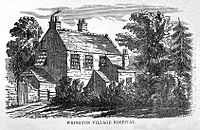
Wrington Cottage Hospital opened in 1864 and admitted 24 patients in its first year of operation.[2] The first surgeon was Horace Swete, who wrote the Habdy Book of Cottage Hospitals.[3] It was referred to by Florence Nightingale in 1869.[4]
Wrington had its own railway station between 1901 and 1963, on the Wrington Vale Light Railway, which ran from Congresbury to Blagdon.
Church
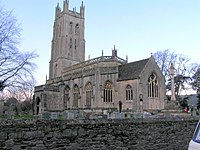
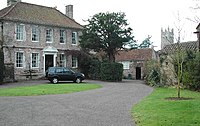
The Church of All Saints has 13th-century foundations. It was remodelled with the addition of a west tower about 1450. There was a restoration in 1859 and further restoration of the tower in 1948.
The church includes on either side of the door stone busts to John Locke and Hannah More dating from the early 19th century. The chancel has an 1832 Gothic reredos by Charles Barry. The rood screen is from the 16th century. It has a tall four-stage tower with set-back buttresses which develop into crocketed pinnacles at the top stage. The top displays moulded string courses and a trefoil-pierced triangular parapet with gargoyles and corner pinnacles.
The church is Grade I listed.[5] According to Freeman it is "one of the "highest achievements of architectural genius".[6] It dates from the period 1420–1450.[7] The belfry stair is in the south-east turret. The height of the tower is 114 feet (35 m) to the top of the pinnacles.[8]
The 17th-century rectory is Grade II listed.[9]
The church's bells ring automatically. Until 2012, this took place every 15 minutes even through the night, but after a noise abatement order was served, it was reduced to hourly during the night.[10][11]
About the village
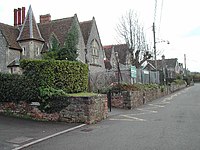
The village primary school was opened on 1 May 1857[12] and is Grade II listed.[13]
A major institution in the local economy is the Butcombe Brewery, a microbrewery set up in the nearby village of Butcombe in 1978 by Simon Whitmore, the managing director of Courage Western, made redundant in a restructuring, and his wife Maureen. In 2003 the business was sold to Guy Newell and Paul Horsley, and moved to an industrial estate at Wrington,[14] to be housed in a purpose-built brewery completed in March 2005. In the same year the brewery set up a joint venture with Thatcher's, the Long Ashton Cider Company, to produce a keg cider. In 2008 output was 24,000 barrels a year and the number of direct outlets was about 450.[15]
Sport
- Football: Wrington Redhill AFC, who play at the recreation ground in Wrington
- Cricket club. The club's facilities and pitch have been improved in the last few years, and alongside the cricket pitch, the club has two nets, used for training sessions for all ages and levels.
Outside links
| ("Wikimedia Commons" has material about Wrington) |
References
- ↑ "Roman Wrington". Wrington Website. Archived from the original on 6 June 2007. https://web.archive.org/web/20070606084447/http://www.wringtonsomerset.org.uk/history/roman/roman1.html. Retrieved 26 February 2007.
- ↑ "Wrington village hospital". Wrington. Archived from the original on 4 March 2016. https://web.archive.org/web/20160304023131/http://www.wringtonsomerset.org.uk/history/villagerecords/page72.html. Retrieved 21 January 2015.
- ↑ Swete, Horace (1987). Handy Book of Cottage Hospitals. Hamilton, Adams and Co. https://books.google.com/books/about/Handy_book_of_cottage_hospitals.html?id=TBcDAAAAQAAJ&redir_esc=y.
- ↑ Nightiongale, Florence (2012). McDonald, Lynn. ed. Florence Nightingale and Hospital Reform: Collected Works of Florence Nightingale, volume 16. Wilfrid Laurier Univ. Press. ISBN 9780889204713. https://books.google.co.uk/books?id=eXHLAgAAQBAJ&pg=PA764&lpg=PA764&dq=Wrington+Village+Hospital&source=bl&ots=fO6I-OSYCh&sig=9UIMNw-3gNSDLb3ZpHxvRIZ0jA4&hl=en&sa=X&ei=io-_VOf2MIOs7Ab5hQE&ved=0CDcQ6AEwBTgK#v=onepage&q=Wrington%20Village%20Hospital&f=false.
- ↑ National Heritage List 1129227: Church of All Saints
- ↑ Brereton, R. P. (1904). "Somerset Church Towers". The Archaeological Journal (Somersetshire Archaeological Society at Gillingham) lxii. 60 collotypes prepared for a planned monograph are in the British Museum, Add. MSS. 37260-3, were published by the Society..
- ↑ Wickham, Archdale Kenneth (1965). Churches of Somerset. London: David & Charles.
- ↑ "Description of the church". All Saints Wrington. Archived from the original on 16 December 2007. https://web.archive.org/web/20071216205625/http://www.wringtonsomerset.org.uk/allsaints/description.html. Retrieved 5 March 2008.
- ↑ National Heritage List 1320920: The Old Rectory
- ↑ Wrington All Saints Church clock silenced in noise row Template:Webarchive, BBC News, 25 April 2012
- ↑ Somerset church bell to ring again after agreement reached Template:Webarchive, BBC News, 2 December 2012
- ↑ Wrington's Victorian Schools, Mark Bullen 2012
- ↑ National Heritage List 1320923: Wrington Primary School
- ↑ "Timeline". Butcombe Brewery. Archived from the original on 1 October 2008. https://web.archive.org/web/20081001225455/http://www.butcombe.com/history.htm. Retrieved 30 September 2008.
- ↑ Pints West, No. 79. Autumn 2008, Campaign for Real Ale, Bristol, p. 12.
